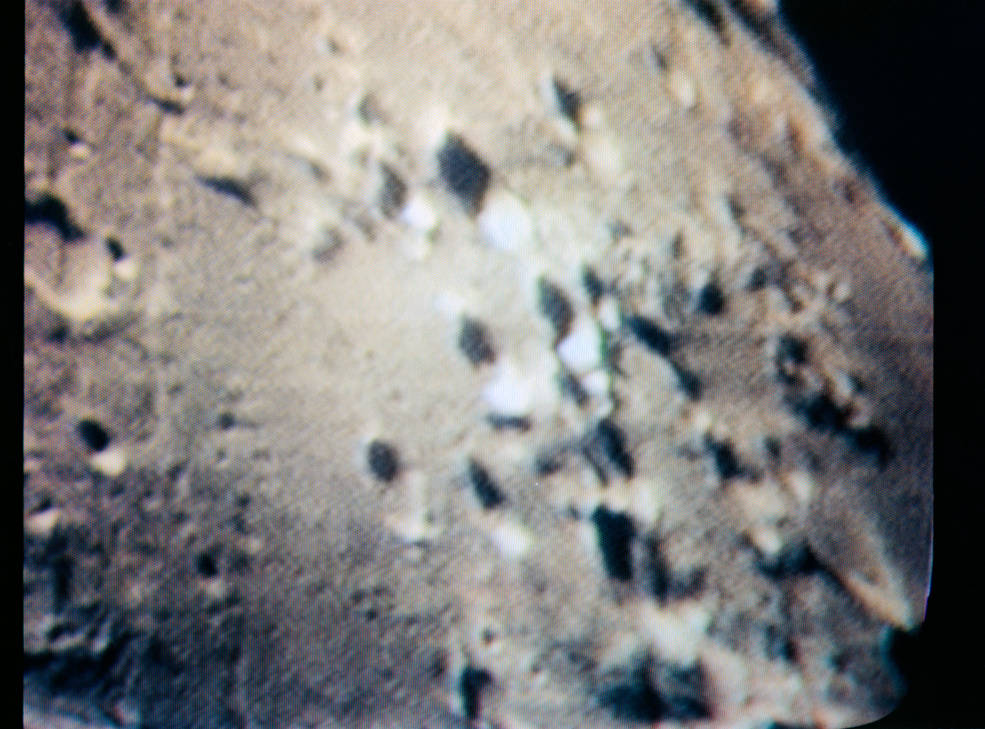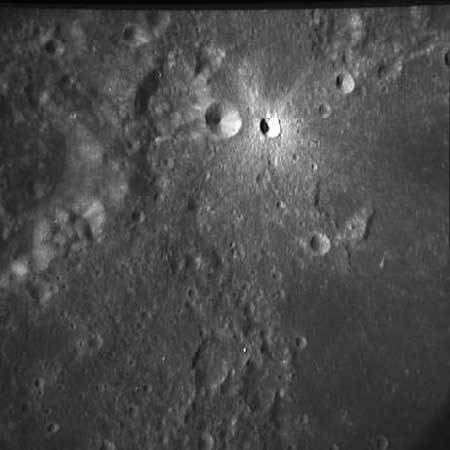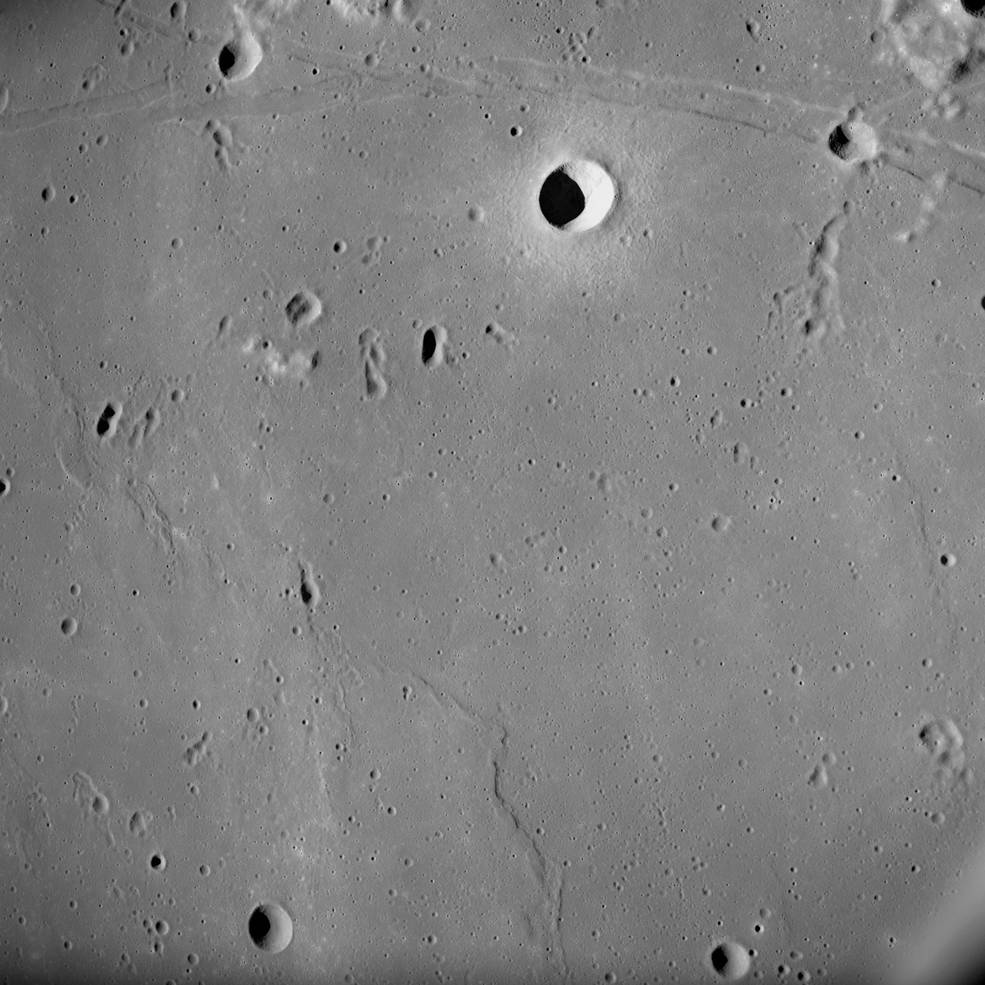Following a trouble-free three-day journey from Earth, Apollo 10 slipped behind the Moon, and communications with Mission Control was temporarily cut off. The Lunar Orbit Insertion (LOI) maneuver, a six–minute firing of the Service Propulsion System (SPS) engine, took place behind the Moon. Only the crew, Commander Thomas P. Stafford, Lunar Module Pilot Eugene A. Cernan, and Command Module Pilot John W. Young, at first knew that the burn was completely successful, placing Apollo 10 into an elliptical 69- by 196-mile orbit around the Moon. As Apollo 10 rounded the backside of the Moon and communications were restored, Stafford radioed to Mission Control, “You can tell the world that we have arrived.” Almost immediately, all three crewmembers began excitedly describing the lunar scenery passing by beneath them, with Cernan summing it up best, “It might sound corny, but the view is really out of this world.” As they crossed the terminator into the night side of the Moon, they were surprised by how many features they could still see, lighted by Earthshine, with Young exclaiming, “Boy, this Moon is lit up like a Christmas tree on the dark side. It is well illuminated from the Earth.”


Left: Astronauts (left to right) Mitchell, Schmitt, Engle, Duke, McCandless, and Slayton gathered around the
Capcom console during the LOI maneuver. Right: Earthrise from Apollo 10.
After two revolutions around the Moon to verify their trajectory, the Apollo 10 astronauts once again fired the SPS engine behind the Moon, this time for 14 seconds, to circularize their orbit at about 69 miles altitude. Shortly after they rounded the backside of the Moon, they began their first TV broadcast from lunar orbit. During the 29-minute telecast, Stafford, Cernan, and Young provided a constant narration of the terrain speeding by below them, including the landmarks leading to the Apollo 11 landing site in the Sea of Tranquility. The quality of the TV broadcast was excellent, with viewers on Earth treated to amazing details of the lunar surface. Shortly after the TV downlink, Cernan opened the hatch to Snoopy for the first time, and floated inside to partially activate the LM, perform a brief inspection, conduct communications checks, and transfer equipment that will be needed later when Snoopy flew free from Charlie Brown. Meanwhile, inside Charlie Brown, Stafford and Young were performing some landmark tracking activities, identifying and photographing targets on the lunar surface. After returning to Charlie Brown, Cernan reported on Snoopy’s condition, “I’m personally very happy with the fellow.” The crew prepared to settle down for their first night’s sleep in lunar orbit, with Cernan asking the ground to “watch Snoopy well tonight, and make him sleep good, and we’ll take him out for a walk and let him stretch his legs in the morning.”



Three views of the lunar surface during a color TV broadcast from Apollo 10. Left: The craters Messier and Messier A in the Sea of Fertility.
Middle: Close-up view of the crater Maskelyne. Right: The crater Gutenberg.
The crew awoke early to begin their busiest day of the mission – an eight-hour sequence of maneuvers in lunar orbit to simulate all operations except the landing itself. All three crewmembers donned their pressure suits, Stafford and Cernan transferred to Snoopy, leaving Young in Charlie Brown, and then they closed the hatches between the two spacecraft. As they prepared to undock Snoopy from Charlie Brown, they couldn’t vent the docking tunnel connecting the two spacecraft. Although the crew believed that some insulation was clogging the vent valve, engineers later discovered that an incorrect fitting had been installed on the valve, preventing air from escaping into space. Mission Control called up a procedure to circumvent that problem, but the crew then noticed that Snoopy and Charlie Brown were out of alignment by 3.5 degrees. Mission Control assured them that as long as the slippage didn’t exceed six degrees, it was safe to undock. With those issues resolved, Mission Control gave the crew the GO to undock just before the spacecraft went out of communication behind the Moon. Out of contact with Earth, Stafford and Cernan deployed Snoopy’s landing gear and soon after Young separated the two spacecraft. Minutes later, Charlie Brown and Snoopy flying separately came around the backside of the Moon and Young began a 20-minute TV transmission, at first showing Snoopy a short distance away. Snoopy began a slow roll so that Young could inspect and photograph the vehicle. Young then fired Charlie Brown’s thrusters to separate from Snoopy, exclaiming, “You will never know how big this thing gets when there ain’t nothing in here but one guy.” To which Cernan replied, “You will never know how small it looks when you’re as far as we are.” Stafford added, “We’ll see you back in about six hours.” And then, it was time to take Snoopy for a walk, and let him stretch his legs, as Cernan had commented the night before.


Left: Charlie Brown from Snoopy, shortly after undocking.
Right: Snoopy from Charlie Brown during the inspection.
A few minutes before the spacecraft disappeared behind the Moon, Mission Control gave Snoopy the GO for DOI – the Descent Orbit Insertion, the burn of the LM’s Descent Propulsion System (DPS) engine to lower its orbit’s low point to about 50,000 feet. As with most critical maneuvers of the mission, this one took place behind the Moon so the low point would be reached on the nearside near the Apollo 11 landing area in the Sea of Tranquility. The 27-second burn began with the engine at 11.3% thrust for the first 15 seconds, then Stafford throttled it up to 40% thrust for the remainder of the maneuver. Stafford and Cernan began taking photographs and film of the surface as they started their descent to what was later calculated to be about 47,000 feet. First Charlie Brown, and then Snoopy came back into communication with Earth, with Cernan reporting to Capcom Charles M. Duke, “We is down among them, Charlie,” referring to their low altitude over the lunar landscape. They successfully tested Snoopy’s landing radar, a critical test before the actual landing mission, all the while continuing a running commentary describing the landscape below them including all the landmarks leading up to the planned Apollo 11 landing site. Several minutes later, they once again fired the LM’s DPS engine for the 40-second phasing burn to set up the right orbital geometry for a simulated liftoff from the Moon during the next orbit. Both spacecraft went around the Moon’s backside again, and once they reestablished contact, Stafford and Cernan prepared to separate the LM’s ascent stage. During the staging, Snoopy experienced some unexpected motions in all three axes that Stafford and Cernan quickly brought under control. The gyrations were later attributed to a switch placed in the wrong position. Ten minutes later, they fired Snoopy’s Ascent Propulsion System (APS) engine for 15 seconds that simulated a liftoff from the Moon and began the rendezvous process to rejoin Young in Charlie Brown, using the same maneuvers as during a landing mission.

Map of the Moon showing the areas in the film below bordered in red.
Watch the film taken by Apollo 10 during their low altitude pass in the LM Snoopy showing the approach to the Apollo 11 landing site: https://www.youtube.com/watch?v=X567kYca11U
Snoopy coasted for about an hour, following which three maneuvers using the ascent stage’s Reaction Control System thrusters brought it close to Charlie Brown. Young completed the docking just after the two spacecraft reappeared from behind the Moon, and Stafford exclaimed, “Snoopy and Charlie Brown are hugging each other.” Snoopy had been on a very long leash, travelling up to 390 miles from Charlie Brown. During its 8-hour 10-minute solo flight Snoopy met all planned objectives. Soon, the crew opened the hatches between the two spacecraft and Stafford and Cernan rejoined Young in Charlie Brown, bringing with them cameras and exposed film. They then closed the hatches for the final time and bid farewell to Snoopy. Due to residual air pressure in the docking tunnel that couldn’t be vented, Snoopy departed at a higher than expected speed. Stafford commented, “Snoop went some place,” and Young added, “Man, when he leaves, he leaves.” To prevent an unwanted recontact between the two spacecraft, Snoopy fired its APS engine to fuel depletion, which sent it safely out of lunar orbit and into an orbit around the Sun. Cernan, perhaps feeling some guilt about disposing of Snoopy, said, “I feel sort of bad about that, because he’s a pretty nice guy; he treated us pretty well today.” After a very busy day, the astronauts settled down for an extended sleep period. The next morning, Capcom Jack R. Lousma called up to the crew with a fictional congratulatory message from the Red Baron, Snoopy’s arch enemy in the Peanuts© comic strip, stating, “Congratulations on doing what I’ve been trying to do for a long time.”


Left: Snoopy ascent stage approaching Charlie Brown. Right: MCC during LM CM docking.
During their last day in lunar orbit, Stafford, Cernan, and Young took stereo images of the Apollo 11 landing site and treated the ground to a 24-minute color TV broadcast, showing views of the lunar surface including the Apollo 11 landing site. One of the three electricity-generating fuel cells began to overheat and had to be turned off temporarily, but that did not result in any change to the flight plan. Near the end of their time in lunar orbit, the crew spotted Snoopy’s descent stage at some distance, still in its elliptical orbit since it was jettisoned the day before. Stafford expressed some concern about a possible recontact, but Mission Control assured him that that was a very remote possibility. During their 31st and final orbit around the Moon, the astronauts prepared the spacecraft for its next critical maneuver, the Trans Earth Injection that would propel them out of lunar orbit and back toward their home planet. As with most critical engine firings, this one occurred while the spacecraft was behind the Moon and out of radio communications with Earth.


Left: Apollo 10 view of the approach to Landing Site 2, the target for Apollo 11.
Right: Overhead view of the Apollo 11 landing site, in the upper right portion of the image.
Watch the TV broadcast from Apollo 10 during their last day in lunar orbit: https://www.youtube.com/watch?v=sVKcEBSb2j4
Read Stafford and Cernan’s recollections of the Apollo 10 mission in their oral histories with the JSC History Office.

























